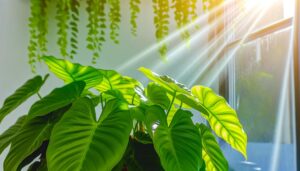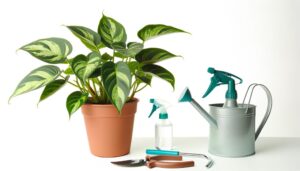How Do I Care for a Climbing Heartleaf Philodendron? Tips!
Caring for a climbing Heartleaf Philodendron, scientifically known as Philodendron hederaceum, involves nuanced measures. Ideal environmental conditions include bright, indirect light and temperatures of 15-29°C, with humidity levels between 40-60%.
The plant thrives in consistently moist, well-drained soil. An appropriate soil mix includes peat moss, perlite, and vermiculite in a 2:1:1 ratio, with a pH ranging from 6.0 to 6.5.
Regular pruning enhances bushier growth and propagation ensures longevity. Pests such as aphids and mealybugs require immediate attention.
Watch out for overwatering signs like yellowing leaves and root rot. Further investigation will reveal deeper insights into the common problems and respective solutions.
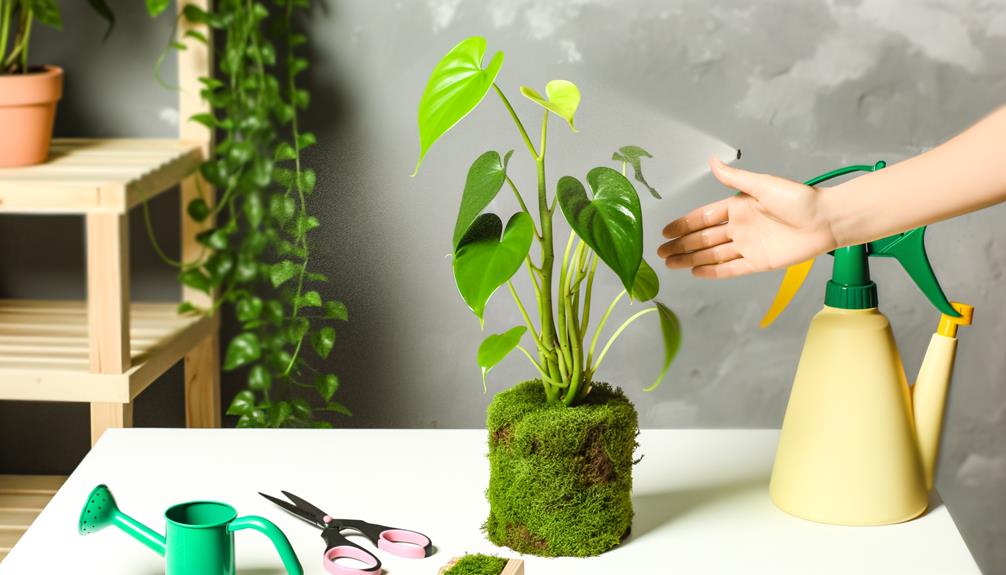
Key Takeaways
- Place your Heartleaf Philodendron in bright, indirect light, avoiding direct sunlight to prevent leaf burn.
- Maintain a consistently moist soil condition, but avoid waterlogging to prevent root rot and yellowing leaves.
- Use a soil mix of peat moss, perlite, and vermiculite in a 2:1:1 ratio, ensuring a soil pH between 6.0 and 6.5.
- The plant thrives in warm temperatures of 15-29°C and high humidity levels between 40-60%, consider using a humidifier or pebble tray.
- Regular pruning promotes bushier growth, and propagation via cutting in a humid environment ensures the plant’s longevity.
Understanding the Heartleaf Philodendron
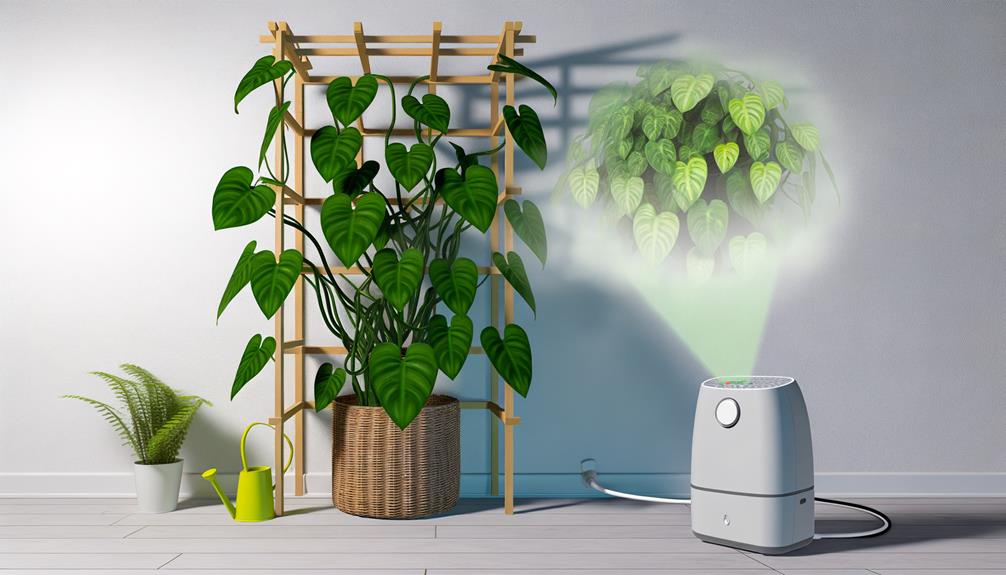
The Heartleaf Philodendron, scientifically identified as Philodendron hederaceum, is a popular indoor vine plant distinguished by its lush, heart-shaped foliage and remarkable adaptability to a variety of environmental conditions. This tropical species, indigenous to Central America and the Caribbean, thrives in a range of light and temperature conditions.
It displays a climbing growth habit, which makes it perfect for interior decoration. The Heartleaf Philodendron is also recognized for its air-purifying qualities. Its capacity to filter out harmful toxins from the surrounding environment contributes to indoor air quality, making it not only a visually pleasing addition to any space, but also a beneficial one.
Understanding its unique characteristics and needs is crucial to providing ideal care.
Ideal Indoor Location
Selecting an ideal indoor spot for your Heartleaf Philodendron involves careful consideration of light exposure, temperature consistency, and humidity levels. Bright, indirect light is best as direct sunlight can scorch their leaves, causing irreversible damage.
The plant thrives in temperatures ranging from 15-29°C, with fluctuations outside this range leading to stunted growth or leaf loss. Additionally, this tropical plant favors a high humidity environment; 40-60% is recommended.
Low humidity can cause leaf browning and curling. It is advised to place your philodendron near a humidifier or in a naturally humid area like a bathroom.
Watering Your Philodendron
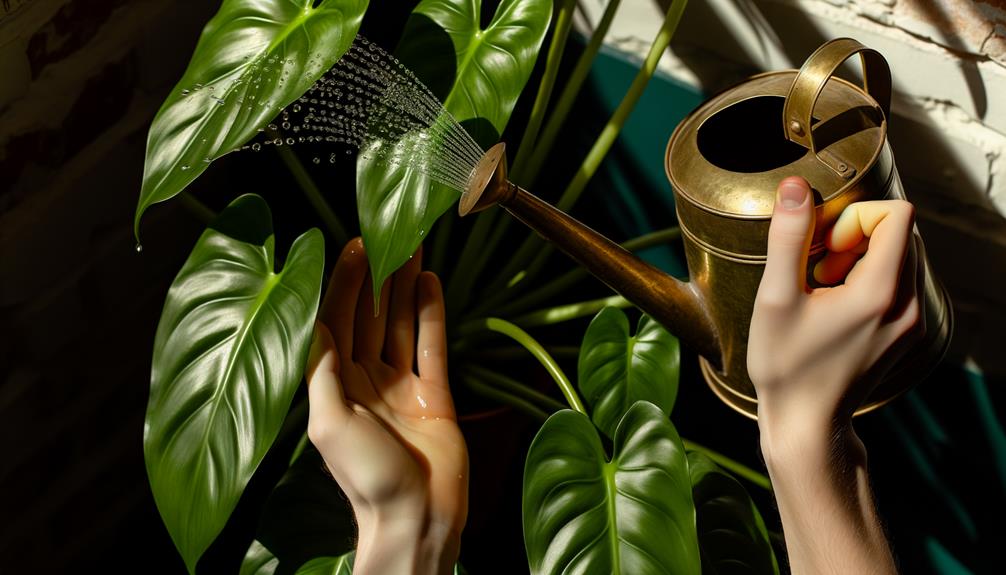
The science of watering a Climbing Heartleaf Philodendron requires a thorough understanding of the plant’s hydration needs.
- The ability to recognize symptoms of over-watering is essential.
- Mastery of an ideal watering technique is crucial.
- Ensuring the correct balance of water for this particular species is vital to its overall health, growth, and longevity.
As such, we will dissect these elements to provide a detailed understanding of the hydration process for this unique plant species.
Understanding Philodendron’s Water Needs
Understanding the watering needs of a climbing Heartleaf Philodendron involves a careful analysis of its unique biological requirements and environmental factors. Excessive or insufficient hydration can greatly affect its growth and overall health.
Ideally, these tropical plants prefer consistently moist but not waterlogged soil. This balance maintains the plant’s metabolic processes, promotes nutrient absorption, and discourages root rot.
Watering frequency is largely dependent on the plant’s environment, specifically humidity and temperature, which can alter evaporation rates. Additionally, seasonality influences the plant’s water needs, with reduced requirements during dormancy in colder months.
Therefore, a thorough understanding of the philodendron’s natural habitat, growth phase, and environmental conditions is essential in devising an effective watering regimen.
Recognizing Over-Watering Signs
While proper hydration is indeed essential for the thriving growth of a climbing Heartleaf Philodendron, it’s equally important to identify and understand the signs of over-watering, as this common mistake can lead to detrimental health issues for the plant.
Over-watered Philodendrons display symptoms such as yellowing leaves, a sign of chlorosis due to oxygen deprivation at the roots. The leaves may also become soft and mushy, indicative of cell wall damage from excessive water intake.
Moreover, a persistent musty odor can signal root rot, a severe condition caused by waterlogged soil conditions, promoting fungal growth. By recognizing these signs, prompt action can be taken to adjust watering practices, thereby ensuring the best health and importance of your Heartleaf Philodendron.
Perfect Watering Technique
To maintain the best health and energy of your Heartleaf Philodendron, it’s important to master an effective watering technique that caters to its specific hydration needs.
The perfect watering routine should balance between over-hydration and under-hydration. This delicate equilibrium is achieved by maintaining the soil’s moisture at a level that is neither too dry nor too waterlogged.
An effective method is to water thoroughly until water drains from the pot‘s bottom, then allowing the soil to dry out partially before the next watering. This cyclic approach mimics the plant’s natural rainforest habitat, supporting ideal growth.
Additionally, using room-temperature, dechlorinated water can prevent root shock and damage. Remember, consistency in watering technique is key to fostering a vibrant, healthy Heartleaf Philodendron.
The Right Soil Mix
What constitutes the best soil mix for a Climbing Heartleaf Philodendron?
- A mixture that retains moisture, yet drains quickly, supports the plant’s health most effectively.
- It’s advisable to use a blend of peat moss, perlite, and vermiculite, with a ratio of 2:1:1, respectively.
- The peat moss serves as an organic matter source, offering essential nutrients.
- Perlite, a volcanic glass, enhances aeration and drainage, preventing water logging.
- Vermiculite, a mineral compound, aids in moisture retention and nutrient supply.
- The soil pH should be slightly acidic, between 6.0 and 6.5, which is best for nutrient absorption.
A well-prepared soil mix not only supports strong growth but also reduces susceptibility to root diseases, contributing to the longevity of your Climbing Heartleaf Philodendron.
Temperature and Humidity Needs
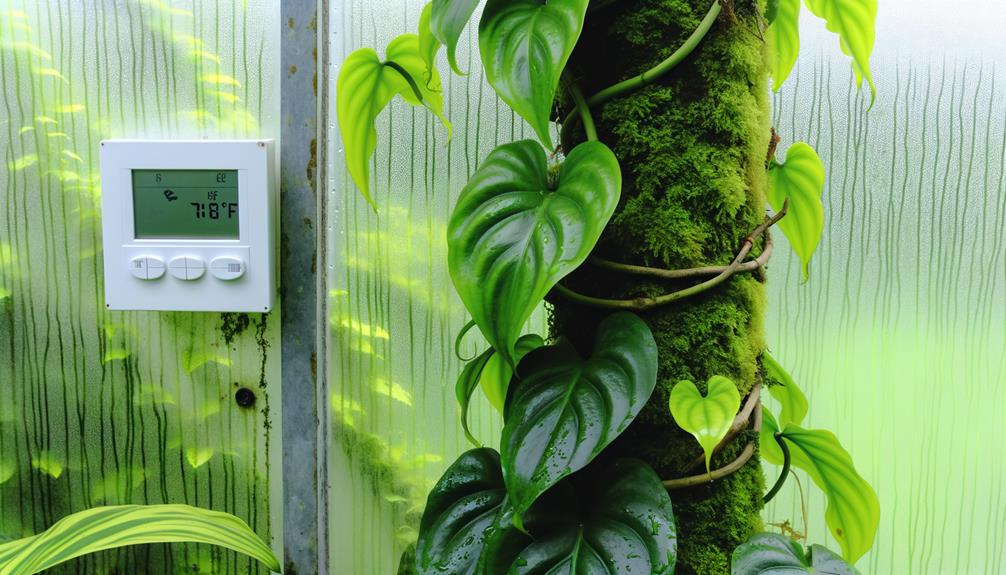
Given their tropical origins, Climbing Heartleaf Philodendrons flourish in warm temperatures and high humidity levels, with the ideal temperature range being between 65 to 80 degrees Fahrenheit. These plants will not tolerate a frost and should be kept indoors in cooler climates.
Humidity: Philodendrons favor humid environments, mimicking their natural rainforest habitat. Indoor growers can increase humidity by placing the plant on a pebble tray filled with water or using a room humidifier.
Temperature: Sudden drops or spikes in temperature can harm the plant. Maintain the temperature within the optimal range.
Monitoring: Regularly check the plant’s environment with a thermometer and hygrometer to ensure it remains in the favorable conditions.
Adhering to these guidelines will optimize your Philodendron’s growth, serving its role in bringing natural beauty into your home or office.
Fertilization Methods
Proper fertilization is key to ensuring a strong and healthy Climbing Heartleaf Philodendron, requiring careful consideration of both the type and frequency of nutrients applied.
A balanced, water-soluble fertilizer, with an equal ratio of nitrogen, phosphorus, and potassium, is ideal to support leaf development and root growth. The recommended application frequency is once a month during the growing season, typically from spring to fall.
Subsequently, in winter months, when growth is dormant, fertilization should be reduced to every six to eight weeks. Over-fertilization can lead to salt accumulation in the soil which may cause leaf burn, so diligent monitoring is critical.
With appropriate fertilization, your Climbing Heartleaf Philodendron will be well-nourished, ensuring utmost growth and foliage vibrancy.
Pruning and Propagation
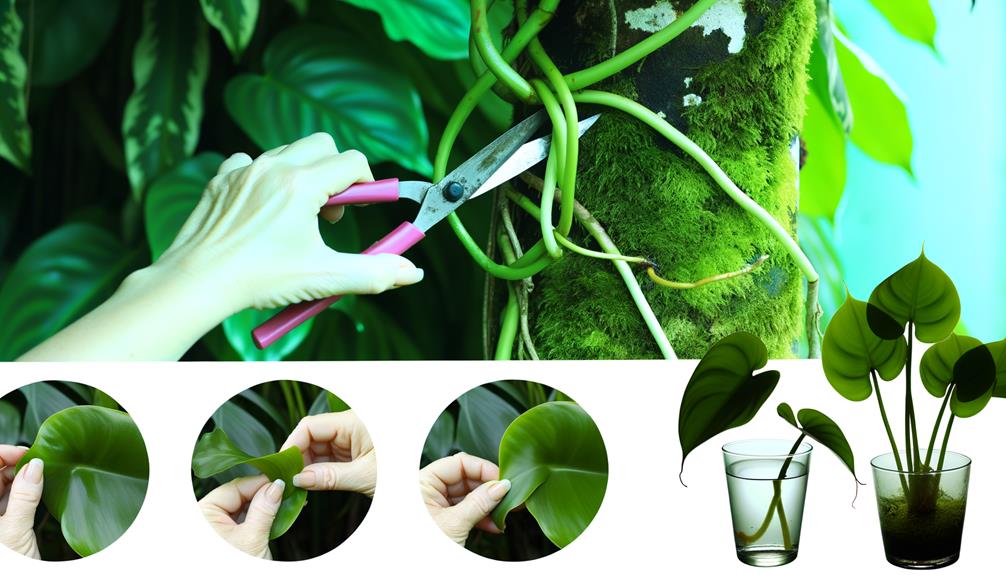
To promote the longevity and health of the Climbing Heartleaf Philodendron, the comprehension of suitable pruning methods is essential.
Additionally, mastering the science of Heartleaf Philodendron propagation can greatly assist in the propagation of the plant.
The following discussion will tackle these important aspects, concentrating on the upkeep of healthy growth to create an ideal environment for your Philodendron.
Understanding Pruning Techniques
Understanding the appropriate pruning techniques is an essential part of maintaining the health and robustness of a Climbing Heartleaf Philodendron, as it not only encourages the growth of the plant but also allows for successful propagation.
- Selective Pruning: This involves removing specific parts of the plant that are overgrown or dead. It’s a strategic method that fosters balanced growth and maintains the plant’s aesthetic appeal.
- Pinching Back: This technique involves pinching off the tips of new growth to encourage the plant to branch out and become bushier. This is particularly useful for Heartleaf Philodendrons as it promotes a fuller appearance.
- Hard Pruning: This is a more drastic measure, used when the plant has become overly large or unruly. It involves cutting back large sections of the plant, which might seem harsh but can stimulate vigorous new growth. However, it should be done tactfully to avoid stressing the plant unnecessarily.
Heartleaf Philodendron Propagation
Building on the principles of selective pruning, pinching back, and hard pruning, the propagation of the Climbing Heartleaf Philodendron involves a deeper exploration of these techniques, focusing specifically on how they can be employed to create new plants from existing ones.
The best time for propagation is during the plant’s active growth phase, usually in the spring. Utilize a sterilized cutting tool to obtain a section of the stem with at least one node and a few leaves. This cutting is then placed in water or moistened soil, which stimulates the emergence of roots.
It is essential to maintain a humid environment to prevent desiccation of the cutting. This methodical process offers an effective way to multiply and preserve this beautiful plant species.
Maintaining Healthy Growth
Maintaining the health and vigor of a Climbing Heartleaf Philodendron involves a careful balance of pruning and propagation methods, both of which are essential to its overall growth and development.
- Pruning: Regular pruning fosters a bushier growth habit and promotes overall plant health. Remove yellowed or brown leaves and trim back excessively long vines to maintain the desired shape.
- Propagation: Propagating your Philodendron guarantees its longevity and creates new plants. Cut a 6-inch length from a healthy stem, with at least two leaf nodes.
- Monitoring: Keep a close eye on your plant. Early detection of pests or diseases allows for timely intervention, securing the plant’s sustained vigor and growth.
Dealing With Pests
In the field of horticulture, managing pests is a common challenge for climbing Heartleaf Philodendron, requiring both vigilance and a solid understanding of the pests that typically invade this type of plant. These pests can include insects such as aphids, mealybugs, spider mites, and scale insects.
Here is a brief table highlighting the pests and their respective management strategies:
| Pests | Management Approach |
|---|---|
| Aphids | Use of insecticidal soap or neem oil |
| Mealybugs | Manual removal or use of alcohol-soaked cotton swabs |
| Spider Mites | Increase humidity, use of miticides |
| Scale Insects | Manual removal or use of horticultural oil |
Understanding your plant’s needs and potential threats can help to guarantee a thriving, healthy Heartleaf Philodendron. Immediate action is essential upon the first signs of infestation.
Signs of Overwatering
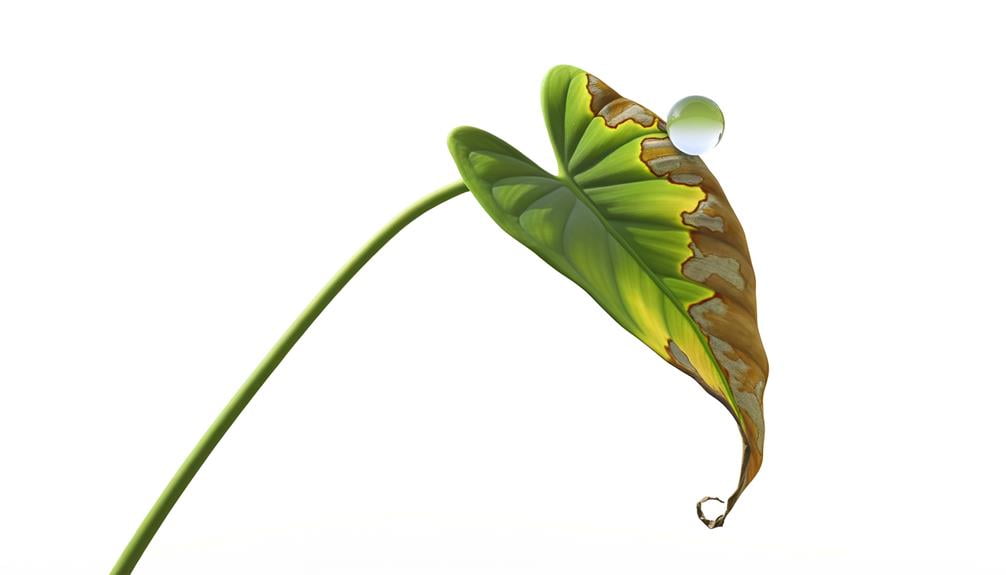
Overwatering, a common mistake made by novice and experienced gardeners alike, can lead to detrimental conditions in Heartleaf Philodendrons, with symptoms often manifesting as yellowing leaves, root rot, and a general decline in plant vigor.
- Yellowing Leaves: Overwatering can cause chlorosis, a condition wherein leaves lose their vibrant green color and turn yellow. This is due to the insufficient supply of oxygen, leading to the breakdown of chlorophyll, the pigment responsible for the green color in plants.
- Root Rot: Excess water creates an anaerobic environment, fostering the growth of harmful fungi that cause root decay, thereby impeding nutrient absorption.
- Declining Vigor: Overwatering can lead to lethargy and stunted growth, as the plant struggles to perform photosynthesis effectively.
These signs warrant immediate attention to prevent further damage to your Heartleaf Philodendron.
Repotting Your Philodendron
While addressing excessive watering is of significant importance, another key aspect in the overall health and longevity of your Heartleaf Philodendron is the process of repotting, which allows the plant’s root system more space for growth and nutrient absorption.
Repotting should be undertaken approximately every 18-24 months, when the plant begins to outgrow its container. Select a pot that is 2-3 inches larger in diameter than the current one. The new pot should have adequate drainage to prevent water stagnation.
Use a well-draining soil mix, rich in organic matter, to ensure top-notch nutrient provision. Carefully disentangle the roots during repotting to enhance their spread and growth in the new space.
Common Heartleaf Problems and Solutions

Despite meticulous care and attention, Heartleaf Philodendrons can occasionally suffer from common plant maladies, necessitating a thorough understanding of these potential issues and their effective solutions.
- Yellow Leaves: This is often a sign of overwatering. Reduce watering frequency and make certain the plant has good drainage.
- Brown Leaf Tips: This can indicate a lack of humidity. Regular misting or placement near a humidifier can alleviate this issue.
- Stunted Growth: This can be due to insufficient light or nutrients. Ensure the plant is receiving bright, indirect light and fertilize it with a balanced houseplant fertilizer.
Heartleaf Philodendron Trellis
A heartleaf Philodendron (Philodendron hederaceum) can be effectively grown on a trellis to showcase its vining nature. To do this, choose a sturdy trellis that fits your space. Secure the trellis in the pot or behind it, ensuring it’s stable.
As the plant grows, gently guide and attach the vines to the trellis using plant ties or soft twine. Regularly prune and train the vines to maintain a tidy appearance and encourage bushier growth. This setup not only enhances the plant’s aesthetic appeal but also supports healthy growth by providing structure for the vines to climb.
Conclusion
The cultivation of a climbing heartleaf philodendron is akin to orchestrating a symphony, requiring a fine balance of elements such as location, watering regimen, soil composition, temperature, humidity, and pest management.
Overwatering signals and repotting strategies further enhance the plant’s growth.
Despite potential problems, with adequate knowledge and meticulous care, the heartleaf philodendron thrives, transforming any indoor space into a lush, verdant sanctuary.

